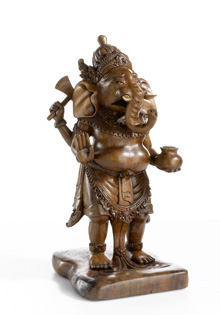
Sculpture Ganesha
The sculpture points Ganesha, the being with elephant's head, and is carved of mahogany wood. Cross the big picture for a detailed view. Choose other views, while you click on the small pictures.
Ganesha is one of the most popular forms of the divine in the Hinduism. Another popular name is Ganapati (Pati of:'Herr', Gana of:'Heerscharen'"). Every Puja (Hindu service) begins with a prayer to him. He is adored if one needs luck for the way or an enterprise, he stands for the beginning and change, linked with protection and calmness, he embodies wisdom and intelligence. The poetry, music and dance belong to his matters and he is man about the sciences. Most businessmen look at him as her patron.
For many devout Hindus is the first what comes to a new house, a statue of the Ganesha. This blesses the house and promises luck. For many Hindu currents Ganesha means a subordinated manifestation of the divine, man all beginning.
Other against it, particularly in the Indian federal state of Maharashtra or in some areas Südindiens, see the most important embodiment of the shapeless highest, the Brahman in him. Mostly Ganesha is shown as a red, stout man or as a child with an elephant's head which has only one tusk often on a Lotusblüte seated. With him is always his riding animal, a mouse or rat who is also under other symbol for intelligence and strength. His four arms are in the Hindu cosmology among other things a sign of virtuosity, from überlegener of (divine) power. They bear in traditional representations arms among other things as a token of the protection and his fight against all evil, a Lotusblüte, among other things sign of the spiritual rebirth, wisdom and cleanness, reincarnation (rebirth). On other representations he carries a book as well as a Mala, a prayer chain. He lost his second tusk after the legend in the fight against Parashurama (Rama-mit-der-Axt), Vishnus the sixth incarnation. His other both hands signal to the believer in certain hand positions Mudras: Is not afraid! (consolation-making a donation Mudra) and promise in the giving gesture his mercy. Mostly a bowl with perfectly round stands 'before him, these are special sweets which show love to food beside multi-layered spiritual meaning Ganeshas. A rat or mouse is his accompanying animal.
Mysteriously appears Ganeshas hybrid form from person and elephant. Soonest understandably she is about the elephant, an important symbolic animal, in the mythology a guard and bearer of the Alls. In the whole Hindu symbolism elephants and Ganesha seem alternate, e.g., luck sign and guardian in dwelling houses just as in temples. Countless legends offer different versions as an explanation of the origin Ganeshas. Reports, e.g., that par daddy, Shivas had created wife, Ganesha in absence Shivas: Therefore, this observed his wife with pleasure near Baden what she did not like, however. Thus she formed from the loam with which she had rubbed her body, a small boy, poured over him with way water and woke him thus to the life. She called him Ganesha and put him as a guard before her bath house. When Shiva came, obstructed Ganesha to him the way. Shiva beat off to him the head and reached thus in the bath Par daddies. When Shiva noted that he had killed just par daddy's son, he ordered to his servants to bring the head of the first living being on which they would hit. The first living being on which they hit was an elephant. His head put Shiva on Ganeshas body to bring back him to the life.
Another stories let Shiva as a father Ganesha without any help create of a woman, while the less known stories of the Vishnu mythology look at the elephant-headed than son of Vishnu. For those believers who see the highest in Ganesha or Ganapati Ganesh Chaturthi (after the lunar calendar is mostly in September) highest of all parties in the annual run; after her faith God comes during these days for visit. Especially admirably the people celebrate the day in Mumbai (early Bombay). Besides, countless small or gigantic Ganesh-Statuen from loam or Pappmaché on altars are put up in houses and streets and some days revere the believers in these representations the divine with regular services, music and dance. On the last day they are dismissed and brought in happy processions to the sea where one sinks them with cheering in the floods.








